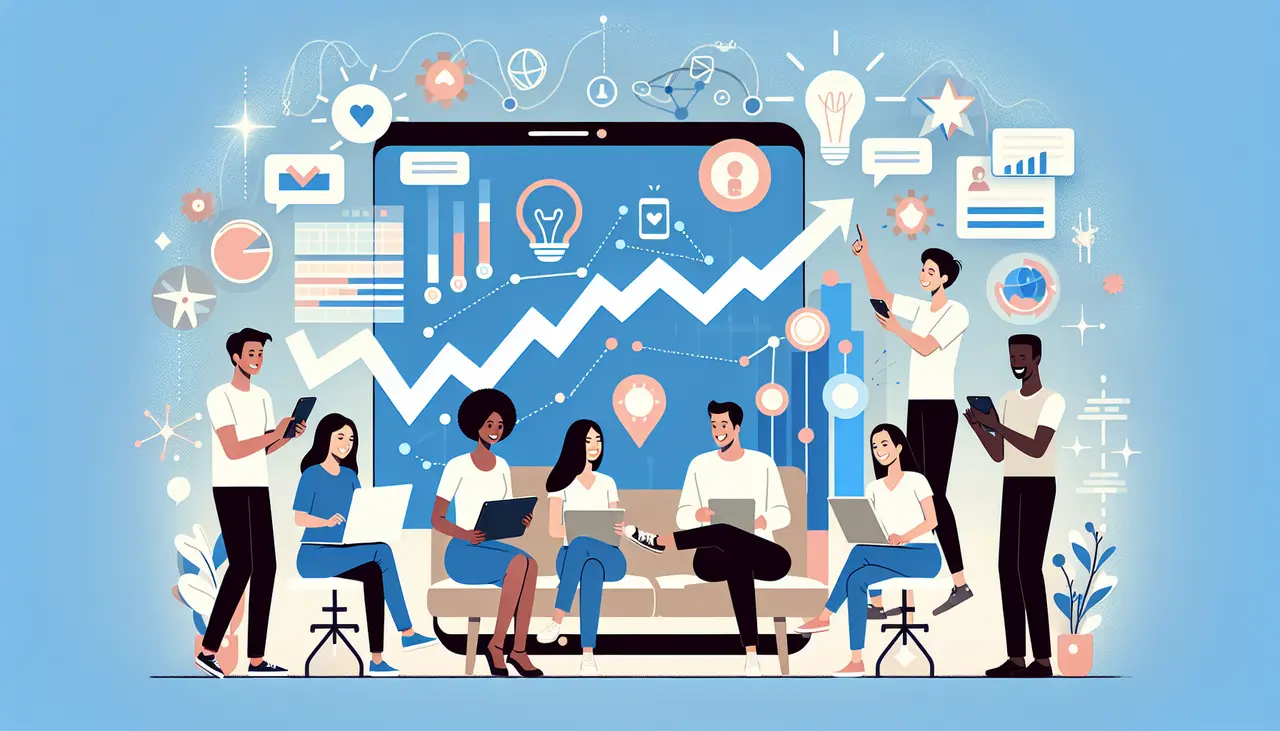In today’s digital age, mobile app development isn’t just a luxury—it’s a necessity for startups. With the surge in smartphone usage over the past decade, apps have become a major component in creating unique customer experiences and driving business success. Let’s explore why investing in mobile app development can be a game changer for your startup.

1. Enhancing Customer Engagement
Mobile apps provide startups with a direct channel to communicate with their customers. Through personalized notifications and messaging, businesses can significantly boost customer engagement and retention. The convenience of having all necessary information on a smartphone makes it easier for customers to stay connected with your brand. By fostering a more personal connection, apps encourage users to engage more frequently with your content and services.
Consider the impact of push notifications. They serve as subtle reminders that can draw users back to your app, increasing the time spent on it and enhancing the overall user experience. This constant interaction helps keep your brand top-of-mind for consumers. Coupled with strategically timed notifications based on user behavior, you can create highly targeted marketing campaigns that resonate with your audience, leading to higher conversion rates and a loyal customer base.
2. Boosting Brand Visibility
A mobile app enhances your brand visibility, ensuring your business is at your customers’ fingertips. This constant presence can increase brand awareness and recognition among potential clients. With an aesthetically pleasing and user-friendly interface, an app can captivate users’ attention, making them more likely to choose your services over competitors. This digital accessibility is not just about being seen; it’s about being remembered.
Moreover, apps can utilize advanced design elements and innovative features that both engage users and enhance brand perception. An app that incorporates your brand’s colors, logos, and messaging can reinforce brand identity. By adding value through interactive features and engaging content, your app not only promotes recognition but also cultivates a relationship that keeps users returning and recommending your app to others.
3. Creating a Personalized User Experience
Apps allow startups to offer customized experiences based on user preferences and behavior. This personalization can lead to increased customer satisfaction and loyalty. By utilizing data analytics, apps can adapt to user behavior, offering personalized recommendations that meet individual needs and preferences. This tailored approach can make users feel valued and understood, driving sustainable customer relationships.
With features like user profiles, saved preferences, and tailored content delivery, a personalized user experience becomes a key differentiator. As users interact with your app, they share insights and preferences that allow you to further refine and enhance their journey. This continuous evolution towards a more personalized experience can help retain customers, reduce churn, and nurture advocacy.
4. Improving Customer Service
Mobile apps can make it easier for startups to provide timely customer support. Features like chatbots and automated responses can quickly address customer queries, enhancing overall service quality. Quick access to help means customers have a smoother journey with fewer obstacles. This immediate support can significantly boost customer satisfaction and foster trust in your service.
Beyond chatbots, integrating other support options like forums, FAQ sections, and user tutorials within your app can further improve service quality. Customers enjoy having multiple avenues to resolve their issues, and apps offer the flexibility to explore these channels conveniently. These features not only provide solutions but also demonstrate a company’s commitment to customer care, which is crucial for retaining customers and encouraging organic growth through positive word-of-mouth.
5. Facilitating Data Collection
Apps are excellent tools for gathering user data, which can be analyzed to gain insights into customer preferences and improve business strategies accordingly. By understanding user interaction and feedback, businesses can adapt their strategies to better meet client needs and expectations. Analytics can unveil invaluable patterns and trends, enabling startups to make informed decisions and to refine their product offerings continually.
Data collection through mobile apps can also inform predictive modeling, allowing startups to anticipate market trends and customer demands. This capability not only streamlines operations but also enhances customer satisfaction by providing them with products and services they truly want. By leveraging data-driven insights, startups can create more effective marketing strategies, optimize customer experiences, and ultimately drive growth.
6. Streamlining Business Operations
A well-designed mobile app can streamline various business operations, from managing inventory to processing payments seamlessly, thus enhancing efficiency. Apps integrate multiple functions into a single, user-friendly interface, reducing the need for disparate systems and increasing productivity. These efficiencies can help businesses scale operations with minimal friction, contributing to overall business growth.
Moreover, implementing automated functions for routine tasks, such as appointment scheduling or inventory tracking, can save time and reduce human error, allowing team members to focus on more strategic activities. This efficiency not only cuts costs but also improves the quality of service delivery, affecting the bottom line positively. Apps enable startups to operate smoother and smarter, which is essential in today’s fast-paced marketplace.
7. Enhancing Reach and Accessibility
With a mobile app, startups can overcome geographical barriers, reaching a broader audience irrespective of location. This accessibility can significantly boost business growth by tapping into new market segments. Apps allow services to be available 24⁄7, which ensures customer access beyond conventional business hours and geographical constraints. This global reach is indispensable for startups aiming to expand their footprint and increase their market share.
Additionally, mobile apps are particularly powerful in reaching demographics that are always on the move, such as millennials, who prefer mobile interactions over traditional ways of doing business. An app’s ability to function across borders, languages, and time zones allows startups to cater to a diverse user base with minimal additional costs. This worldwide accessibility is a critical asset for startups poised for expansion and seeking to build a strong, international brand presence.
8. Supporting Direct Marketing
Apps provide a platform for direct marketing. Startups can inform users about new products, special offers, and updates, driving sales and customer interest. The versatility of apps means they can be used to curate promotional content and deliver it directly to a select audience, capitalizing on immediate user engagement. Mobile notifications and in-app advertisements are effective ways to keep your audience informed and engaged.
Moreover, promotions can be tailored in real-time through the app, giving businesses the flexibility to run seasonal sales, flash discounts, and loyalty rewards programs that encourage frequent app use. By utilizing app analytics, businesses can track the effectiveness of their marketing campaigns and refine them to match their audience’s interests. This not only boosts profitability but also strengthens the brand’s relationship with its customers.
9. Improving Revenue Streams
Monetization options like in-app purchases and subscription models can create additional revenue streams for startups, contributing to financial growth. These strategies, when aligned with user preferences, can offer immense profitability. Many businesses have successfully leveraged in-app advertisements and partnerships as vital revenue components.
Furthermore, by providing users with value-added services such as exclusive content or premium features, startups can create enticing subscription plans that users are willing to pay for. Payment processing integration within the app simplifies transactions, encouraging more users to complete purchases. By diversifying revenue channels through app features, startups can bolster their financial stability and sustain long-term growth.
10. Building a Stronger Customer Relationship
Continuous interaction through an app helps in building stronger relationships with customers, fostering trust and loyalty over time. Features that enable direct communication, such as in-app messaging and user community forums, facilitate meaningful exchanges that enhance the user experience. By providing a personalized customer journey, apps can maintain engagement and reinforce a customer’s emotional connection with the brand.
Also, you can utilize user behavior data to offer bespoke rewards that acknowledge loyalty, such as personalized discounts or exclusive previews. This rewards-based engagement develops a sense of belonging among users, who feel appreciated and valued. Over time, these efforts strengthen brand affinity, making it less likely for customers to switch to competitors.
11. Gathering Customer Feedback
Mobile apps facilitate easy feedback collection, enabling startups to understand customer needs and address issues more effectively. By providing a feedback loop, businesses have the opportunity to continuously improve their product offerings and customer experience. Apps can feature surveys, polls, and direct contact forms that encourage users to willingly share their thoughts, enhancing products based on actual user input.
The feedback collected is invaluable in refining the app’s functionality and addressing any emerging concerns promptly. This responsiveness not only shows that the business values customer opinion but also increases trust in the brand’s commitment to customer satisfaction. Iterative improvements based on feedback help businesses stay ahead of trends and meet evolving consumer demands.
12. Staying Ahead of Competitors
Having a mobile app can give startups a competitive edge, particularly in industries where digital interaction is the norm. It’s a proactive step towards future readiness. Apps position startups as innovative leaders in their field, offering features and conveniences that might not be available through traditional business methods. This technology-forward approach differentiates brands in crowded markets.
Keeping pace with technological advancements through apps not only shows a willingness to innovate but also signifies a commitment to meeting customer expectations in a rapidly changing environment. Apps can serve as platforms for introducing pioneering functionalities that attract tech-savvy audiences. By being early adopters of mobile technology, startups demonstrate their forward-thinking mindset and adaptability, crucial qualities for long-term success.










